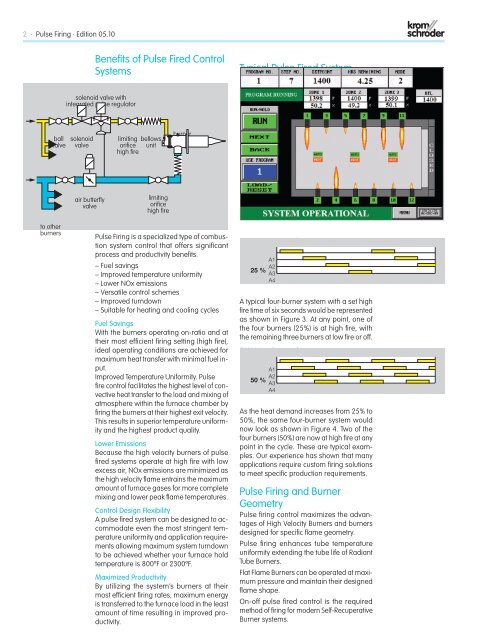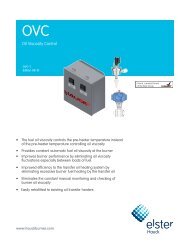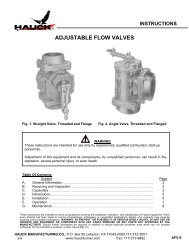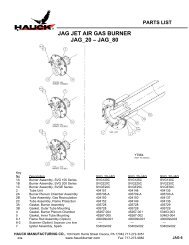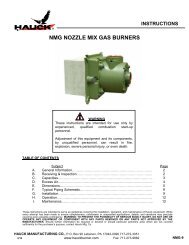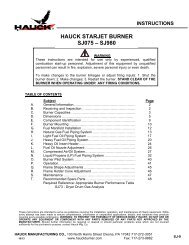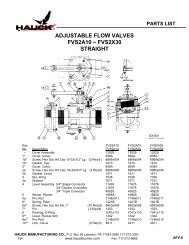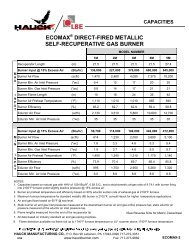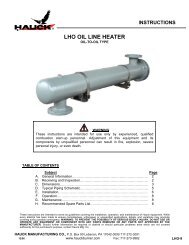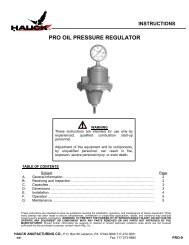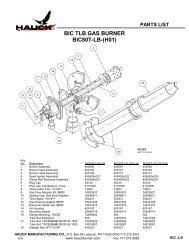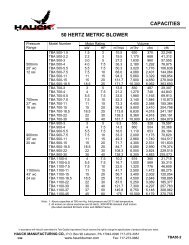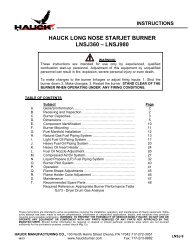Pulse Firing - Hauck Manufacturing
Pulse Firing - Hauck Manufacturing
Pulse Firing - Hauck Manufacturing
You also want an ePaper? Increase the reach of your titles
YUMPU automatically turns print PDFs into web optimized ePapers that Google loves.
2 · <strong>Pulse</strong> <strong>Firing</strong> · Edition 05.10<br />
Benefits of <strong>Pulse</strong> Fired Control<br />
Systems<br />
Typical <strong>Pulse</strong> Fired System<br />
solenoid valve with<br />
integrated pulse regulator<br />
ball<br />
valve<br />
solenoid<br />
valve<br />
limiting<br />
orifice<br />
high fire<br />
bellows<br />
unit<br />
burner<br />
air butterfly<br />
valve<br />
limiting<br />
orifice<br />
high fire<br />
to other<br />
burners<br />
<strong>Pulse</strong> <strong>Firing</strong> is a specialized type of combustion<br />
system control that offers significant<br />
process and productivity benefits.<br />
– Fuel savings<br />
– Improved temperature uniformity<br />
– Lower NOx emissions<br />
– Versatile control schemes<br />
– Improved turndown<br />
– Suitable for heating and cooling cycles<br />
Fuel Savings<br />
With the burners operating on-ratio and at<br />
their most efficient firing setting (high fire),<br />
ideal operating conditions are achieved for<br />
maximum heat transfer with minimal fuel input.<br />
Improved Temperature Uniformity. <strong>Pulse</strong><br />
fire control facilitates the highest level of convective<br />
heat transfer to the load and mixing of<br />
atmosphere within the furnace chamber by<br />
firing the burners at their highest exit velocity.<br />
This results in superior temperature uniformity<br />
and the highest product quality.<br />
Lower Emissions<br />
Because the high velocity burners of pulse<br />
fired systems operate at high fire with low<br />
excess air, NOx emissions are minimized as<br />
the high velocity flame entrains the maximum<br />
amount of furnace gases for more complete<br />
mixing and lower peak flame temperatures.<br />
Control Design Flexibility<br />
A pulse fired system can be designed to accommodate<br />
even the most stringent temperature<br />
uniformity and application requirements<br />
allowing maximum system turndown<br />
to be achieved whether your furnace hold<br />
temperature is 800ºF or 2300ºF.<br />
Maximized Productivity<br />
By utilizing the system’s burners at their<br />
most efficient firing rates, maximum energy<br />
is transferred to the furnace load in the least<br />
amount of time resulting in improved productivity.<br />
25% Heat Demand<br />
A1<br />
A2<br />
25 %<br />
A3<br />
A4<br />
A typical four-burner system with a set high<br />
fire time of six seconds would be represented<br />
as shown in Figure 3. At any point, one of<br />
the four burners (25%) is at high fire, with<br />
the remaining three burners at low fire or off.<br />
50% Heat Demand<br />
A1<br />
A2<br />
50 %<br />
A3<br />
A4<br />
As the heat demand increases from 25% to<br />
50%, the same four-burner system would<br />
now look as shown in Figure 4. Two of the<br />
four burners (50%) are now at high fire at any<br />
point in the cycle. These are typical examples.<br />
Our experience has shown that many<br />
applications require custom firing solutions<br />
to meet specific production requirements.<br />
<strong>Pulse</strong> <strong>Firing</strong> and Burner<br />
Geometry<br />
<strong>Pulse</strong> firing control maximizes the advantages<br />
of High Velocity Burners and burners<br />
designed for specific flame geometry.<br />
<strong>Pulse</strong> firing enhances tube temperature<br />
uniformity extending the tube life of Radiant<br />
Tube Burners.<br />
Flat Flame Burners can be operated at maximum<br />
pressure and maintain their designed<br />
flame shape.<br />
On-off pulse fired control is the required<br />
method of firing for modern Self-Recuperative<br />
Burner systems.


